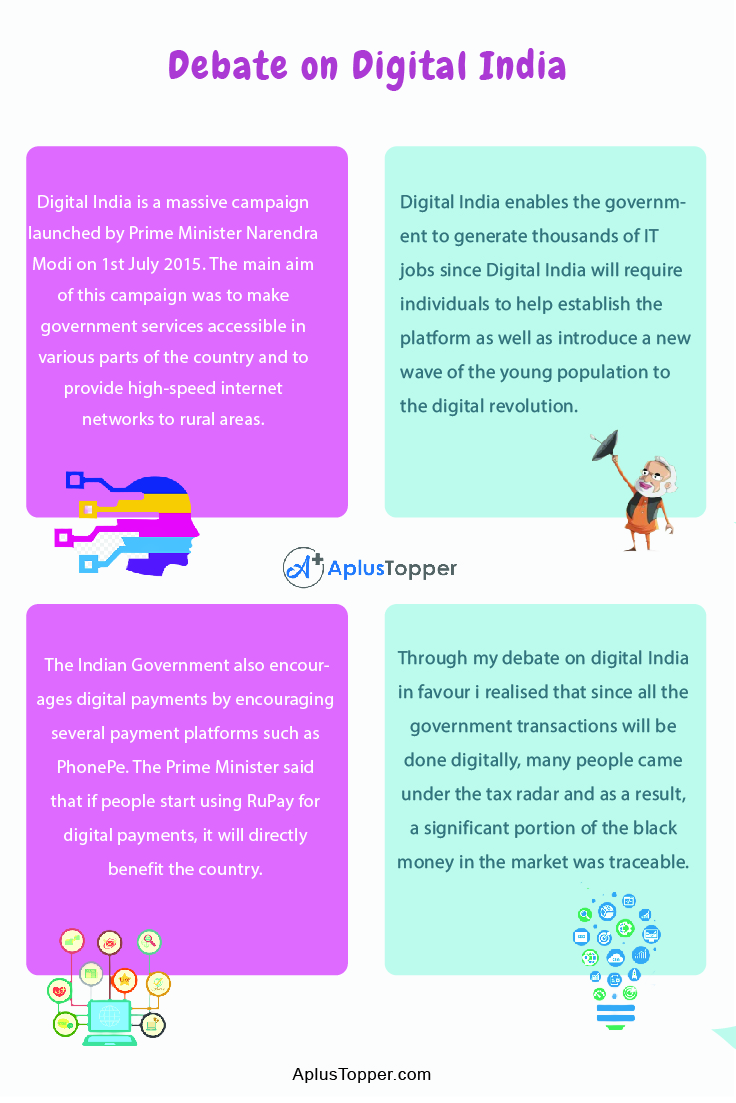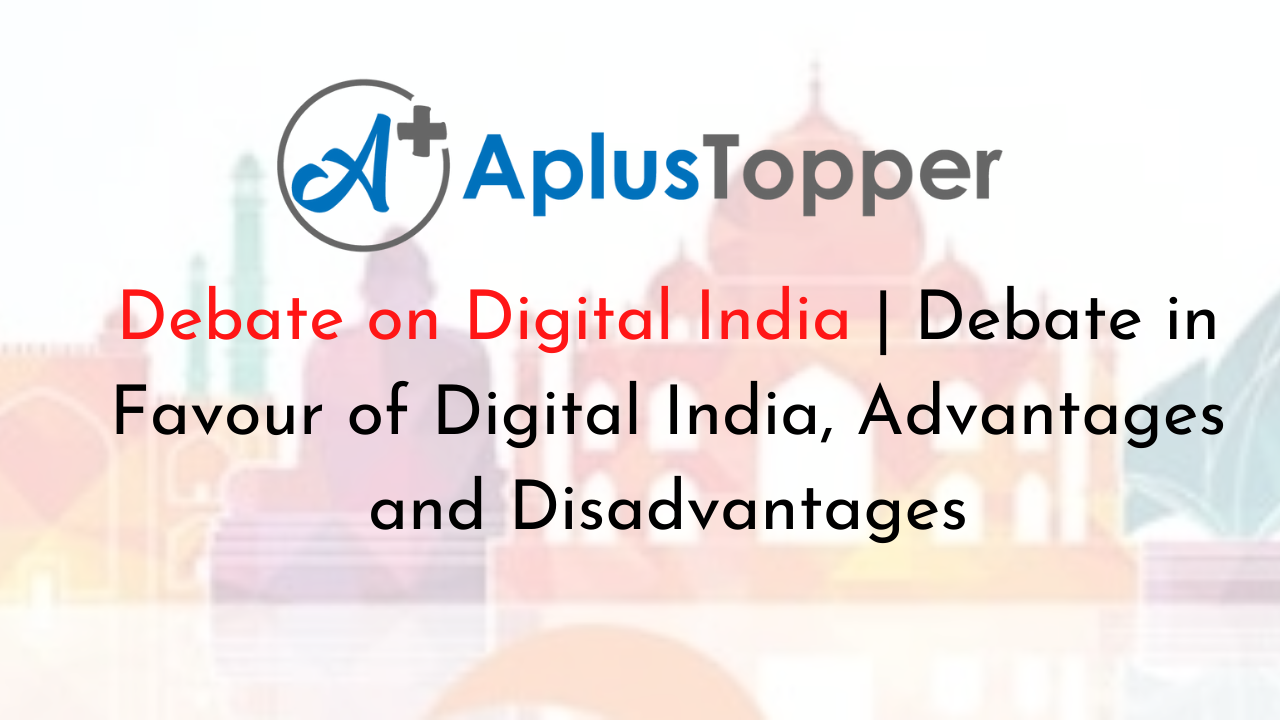Debate on Digital India
India has seen a dream of Digital India. From the latest science to the latest technology, everything should be available at the tip of one’s finger
– Narendra Modi
This is the dream of our Respected Prime Minister Narendra Modi to connect entire India over a single network and to transform India into a digitally empowered society and knowledge economy.
You can also find more Debate Writing articles on events, persons, sports, technology and many more.
A very Good Morning to the Respected Chief Guest, Honorable Dignitaries, Principal Ma’am, all the Teachers and everyone present here. First of all, I would like to thank Principal Ma’am for giving me the opportunity to participate in a debate on Digital India and express my views. In my opinion, digital India proved to be more beneficial to the country so let me speak in favour of the debate on digital India.
Before actually starting the discussion on the debate on digital India let me explain the main objective of Digital India.
Digital India is a massive campaign launched by Prime Minister Narendra Modi on 1st July 2015. The main aim of this campaign was to make government services accessible in various parts of the country and to provide high-speed internet networks to rural areas. The government worked on improving access to technology to the remote and rural people of the country. The objective behind it was to connect the rural parts of the country with high-speed internet.
The project is run by a Government network connectivity called Bharat Broadband Network Limited (BBNL).
In my debate on digital India I would like to highlight that Digital India has launched a number of government services online some of them are:
- Launched a new website named Mygov.in where people can share their ideas on the administration’s policy and the overall governance. This is introduced so that citizens can come forward and actively participate in the process.
- Digital Attendance was introduced to keep the attendance of government employees. The initiative was launched in Delhi and made use of a Biometric System to mark the attendance.
- An application named UMANG abbreviated as Unified Mobile Application for New-age Governance developed for all mobile platforms allows people to access government services such as tax payment, railway ticket booking, education portals, a digital locker and a biometric identification system called AADHAR. It is available in multiple Indian languages.
- eHospital application that provides access to various hospital services such as online lab reports, payment gateway, book an appointment, etc.
- eSign allows the registered citizens to digitally sign a document using their AADHAR cards as a means of authentication.
- A digital locker that helps Indian citizens to store all their government documents digitally and there is no need for citizens to carry a physical copy.
These documents are authenticated by the government itself.
A majority of the rural population did not have internet access. The Prime Minister of India, Narendra Modi also undertook an initiative to make rural households digitally literate. Digital literacy means letting rural people make use of the internet in order to improve the overall quality of life. The government also wants to make digital payment platforms popular which will be more convenient for businesses.
Digital India enables the government to generate thousands of IT jobs since Digital India will require individuals to help establish the platform as well as introduce a new wave of the young population to the digital revolution.
According to my research on the debate on digital India, Digital India is successful in connecting more than 250,000 villages throughout the country. Every village now has access to high-speed internet provided by a government-owned telecom called the BBNL.
The Indian Government also encourages digital payments by encouraging several payment platforms such as PhonePe. The Prime Minister said that if people start using RuPay for digital payments, it will directly benefit the country. Because of inadequate infrastructure, IT companies started hiring more people in order to develop more such apps.
Through my debate on digital India in favour i realised that since all the government transactions will be done digitally, many people came under the tax radar and as a result, a significant portion of the black money in the market was traceable. This led to a sudden increase in the revenue collected by the government and an enormous decrease in the amount of black money people had.
In my debate on digital India, you will find how helpful this is for people living in rural areas. People from all over India can now directly get access to a large number of government agencies from the comfort of their homes. They don’t have to travel hours to visit the government offices.
The rural part of India with the majority of the population, suddenly found themselves interconnected, directly benefiting millions of lives. Farmers can now communicate easily with the experts on a range of farming subjects and get better production.
So here I conclude my debate on digital India. I hope it will help you understand how important it is for the growth of our country.

FAQ’s on Debate on Digital India
Question 1.
What are the objectives of Digital India?
Answer:
The government of India wanted the rural public to make use of the internet and offer them access to various government services online.
Following are the main objectives of digital India:
- A digital infrastructure connecting every rural and urban part of the country together.
- Easy access to online government services.
- Digital literacy of the people.
- Create a digital identity for each and every one.
Question 2.
What are the nine pillars of digital India?
Answer:
The Nine Pillars of Digital India are as follows
- Broadband Highways.
- Universal Access to Mobile Connectivity.
- Public Internet Access Programme.
- e-Governance: Reforming Government through Technology.
- e-Kranti – Electronic Delivery of Services.
- Information for All.
- Electronics Manufacturing.
- IT for Jobs
- Early Harvest Programmes
Question 3.
How has digital India helpful in removing black money from the country?
Answer:
Because of digital India, all online transactions can be monitored easily. As every payment made by any customer to any merchant is recorded, there will be no illegal transactions and it’ll be impossible for people to make money. By using cashless transactions that are digital payments the government can efficiently lower the black economy.
Another big advantage of digital India is that as the transactions are recorded, transactions get digitized, monitoring the sales and taxes becomes much more convenient. Customers will now get a compulsory bill for every purchase they make so that merchants can now no longer escape from paying tax to the government. This results in increases of revenue of the government which will increase the overall financial status of the country.
